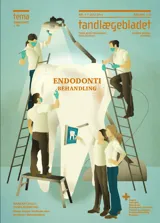Den biomekaniske udrensning - rationale, effekt og kliniske principper
Ved rodbehandling er den biomekaniske udrensning central i forebyggelsen eller behandlingen af den apikale parodontitis. Den udgør den kombinerede instrumentelle og medikamentelle behandling af rodkanalen. I nærværende artikel gennemgås principperne for den biomekaniske udrensning samt omtale af rodmål og instrumentdesign. En korrekt håndtering af rodkanalinstrumenter er samtidig vigtig i forebyggelse af instrumentfraktur. Laboratoriestudier understøtter, at nyere rodkanalinstrumenter har optimerede tekniske egenskaber i forhold til frakturrisiko. Hvorvidt de samme instrumenter reelt fører til forbedrede kliniske resultater, er derimod ikke systematisk undersøgt. Der gennemgås fire væsentlige faser indenfor den specifikke mekaniske udrensning, der kan opfattes som værende alment gældende uden fokus på et bestemt instrumentsystem. Som en konklusion vil det være den samlede effekt af alle delsekvenser i behandlingen, som fører til det optimale kliniske resultat, mere end om filen udfører rotererende eller reciprokerende bevægelser i rodkanalen.
Biomechanical instrumentation – rationale, efficiency and clinical concepts
Biomechanical instrumentation is an important part of preventing or treating apical periodontitis. It comprises the instrumentation and irrigation of the root canal. This article reviews the principles of biomechanical instrumentation. A discussion is presented of estimation of the working length and the design of root canal instruments. A proper handling of instruments is shown as necessary to prevent the breakage of instruments. Studies in the laboratory reveal the new technical improvements of new root canal instruments, whereas less is known about clinical improvement in the use of these instruments. The description of four major phases of instrumentation is presented, which is unrelated to any specific make of instrument. In conclusion, it is the combined efficacy of the sub-sequences in a protocol which leads to the optimal outcome, more than the particular method of operating an instrument such as a rotating or reciprocating file.


